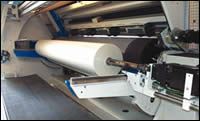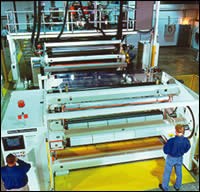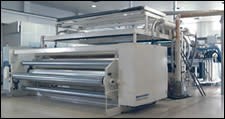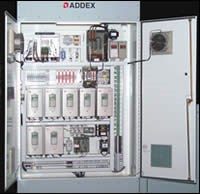Winders: They're Pushing New Limits In Speed and Tension Control
New-generation winders for blown and cast film are winding bigger, better rolls at higher speeds and lower tension. They've gotten so fast that cast film lines can now realize their full productive potential.
Winders for both cast and blown film have changed greatly over the past three to five years. They now wind larger diameters and better-quality rolls out of thinner, stretch ier films at higher speed and lower tension. This is the result of not one development but many. Starting in the mid 1990s, load-cell tension controls, tapered-tension capability, and AC flux-vector drives began replacing dancer tension control and DC drives.
Macro Engineering supplied its first flux-vector drive in 1990 for an experimental extrusion coating line that wound coated paper at 3500 ft/min. (Paper can wind at 8000 ft/min and nonwovens at 4500 ft/min because they’re non-stretchy, porous, and don’t trap air.)
The first plastic film winder with an AC flux-vector drive controlled by a touchscreen PLC was Battenfeld Gloucester’s Model 1011 small turret center winder designed for three-layer blown film in 1991. Black Clawson and Reinhold both delivered their first AC vector drives and PLC controls on plastic film winders in 1996. By five years ago, most winder makers were building some models with AC drives and PLCs. By two years ago, virtually all makes and all models had switched to these technologies.
The big advantage of AC drives isn’t speed, but low maintenance. DC drives have brushes that have to be replaced and can run at lower speeds only with external air cooling. AC drives have no brushes, don’t need cooling, are more precise, and have greater speed range. More recently, AC servo drives have been used instead of AC vector types to give more accurate speed and position control.
With DC drives, speed and torque aren’t linear, and at speeds below 10% there’s no torque at all. On the other hand, AC motors—both vector and servo—have absolutely linear torque development from zero to maximum speed. That means that a DC drive has a usable speed range of about 80:1; and AC vector or servo drives have a 2000:1 range.
Why is such a speed range necessary? Center-drive winding starts at high winding-shaft rpm at the core and tapers to very low speed as the roll builds in order to keep constant roll-surface speed. The speed taper is at least 10:1 and may be 25:1 for bigger diameters. Jumbo rolls of up to 60 in. and rolls of very thin, stretchy materials may require tension tapering of as much as 100:1, says Black Clawson.
Multiply that ratio times the range of line speeds, which may range from 450 ft/min for very thin film down to 30 ft/min for very thick film, a range of 15:1. That means a winder needs a speed range of 1500:1 to run that array of products today.
The highest practical winding speeds for cast film today are probably 2500 ft/min for stretch film and 2000 ft/min for BOPP—up from 1500 to 1700 ft/min for both a few years ago. “Now cast film lines are no longer winder-limited,” says Ricky Keller, sales/marketing director for coating and film at Davis-Standard.
Film winding runs even faster in secondary processes like printing, coating, and laminating. For example, a Davis-Standard Meridian winder reportedly handles coated/laminated, metalized film and BOPP snack-food packaging at up to 2500 ft/min. Keller says, “That may be about as fast as film will ever go because of the need to evacuate air as it winds.”
New-generation winders can also maintain lower tensions at lower line speeds than ever before—an advantage with soft, thin webs like prestretched stretch film and with blown films. Blown film is inherently less even in gauge than cast, so it needs to be wound more loosely to make a flat roll. If stretchy films are wound too tightly, thin areas get thinner, and thick areas become ridges. With thin films, the gauge variation may be smaller, but a roll accumulates many more layers, so the total effect of the variation on roll quality may be greater. Blown film winds typically at 300 to 350 ft/min and up to 500 to 600 ft/min for thin or oriented film. HDPE blown film can wind at up to 1000 ft/min.
Higher winding speeds and better tension control are “changing the paradigm,” notes Mirek Planeta, president of Macro Engineering & Technology. “We’re retrofitting winders on a lot of lines all over the world for this reason.” Older winders are being rebuilt with new drive motors, electronics, and load cells at two-thirds the cost of a whole new winder.
Newer high-speed winders use different roller configurations than past models. For example, Davis-Standard’s Model 2300 cast film winder for up to 57-in.-diam. rolls has only three idler rolls vs. five before. Hosokawa Alpine American’s latest center winder uses more S-wrap configurations, replacing driven pairs of nip rolls. All manufacturers today use carbon-fiber idler rolls for light weight, rigidity, and reduced vibration at high speeds.
Jumbo rolls used in high speed converting lines are getting bigger and heavier. Brueckner Maschinenbau in Germany claims to have built the world’s biggest winder to handle 10-meter-wide PP webs and 60-in.-diam. rolls that weigh 26,000 lb. Brueckner has built four of these behemoths since 1997.
Battenfeld Gloucester’s Model 1022 surface winder handles 60-in.-diam. rolls weighing up to 7000 lb. (A version has also been designed for 72-in. rolls.) Gloucester’s Model 1037 cast film winder for OPP supports a 10,000-lb roll, and a model is being built for rolls up to 12,000 lb.
Going for zero tension
Precision load cells and newer roller configurations allow much lower winding tensions. Black Clawson uses servo drives and special lay-on rolls to maintain tension as low as 2 lb across a 90-in. web, or 0.02 pli (lb/lineal in.). Windmoeller & Hoelscher has a lay-on roll that is counterbalanced for zero weight and uses a servo motor to apply tension as light as 4 lb across a 100-in. web (0.04 pli). A light tension profile might start at 10 lb and taper to 2 or 4 lb at the periphery of a full roll.
Black Clawson is now developing a “zero-tension” winder for exotic films. It senses the film surface to maintain a certain droop, says product manager Robert Moeller.
Better low-tension control improves roll quality for cast PP film, which is a difficult product because it keeps shrinking as it crystallizes for 48 hr or more after winding. If enough air isn’t wound into the roll to allow for that shrinkage, the roll hardens and can crush the core. Center/surface winding with low tension can wind a controlled amount of air between the layers, notes Gerd Kasselmann, managing director of W&H’s Reinhold Div.
Polyethylene, which doesn’t shrink as much, is wound in tighter rolls, keeping air out. These rolls need to be tighter at the core and looser on the outside because tension relaxes in the core but remains taut in the outer 20 in. of roll diameter.
To provide low-tension control in blown film, Addex last year developed a high-end surface/gap winder called Superwind. It has a bank of 13 AC servo motors with direct torque control—six per winding station plus one for the input nip. Each winding roll has a large motor at one end and a small motor at the other for roll transfer. It also has load cells with fiber-optic wiring at each end of the idler roll behind the drum to monitor actual tension. The Superwind controls tension based on torque data from all these drives and uses the load cells only to calibrate and verify tension.
This system provides more precise tension control, says Addex president Rick von Kraus. He claims it is accurate within 2% to 3% vs. 10% to 15% for tension control based on load cells alone. “Using load cells to control motor speed is only accurate when no slippage occurs,” he notes. If slippage occurs in one tension zone, it affects the next, creating a pumping effect.
Reifenhauser’s high-speed UFA III winder, integrated with Rockwell Automation’s Control Logix PLC, controls tension by means of sensor data from the motor and three to seven driven rollers linked by a fieldbus. Tension is measured, but not controlled, via signals from high-speed load cells. Load cells measure strain-gauge deflection on an idler roll, giving an electronic signal proportional to actual tension.
Instead of pneumatic or hydraulic pressure, Reifenhauser uses a servo drive on a shaft to create mechanical pressure on the contact drum for surface winding. That servo pressure can go as low as 50 N (11.25 lb), making it possible to wind thin, sticky film in pressure rather than gap mode. Model UFA III can wind up to 59-in.-diam. rolls.
Kiefel a few years ago bought Wintech Winding Technology in Switzerland and the high-end orbital-winder business of Christian Maier GmbH in Germany. Kiefel combined the two product lines under its Kirion brand. The Kirion W-M (Wintech Multi-purpose) surface/center/gap winder controls tension down to 40 N (9 lb) for winding very thin film. Its patented CLP2 (Constant Lay-on Pressure) control and special “anti-bending” carbon-fiber roll prevent air entrapment.
Bigger, better, faster
Alpha Marathon, which builds turret winders for blown and cast film, recently introduced a high-speed rewinder for gusseted film, capable of winding at 1200 ft/min with fully automatic roll changes every 20 sec.
Black Clawson is developing a new “anvil” for automatic cutover of polyester film and OPP, using a servo-driven blade to punch against a backing roller. The impact of a blunt edge against the backing roll reportedly cuts brittle polyester without shattering it. The servo drive accelerates the anvil holder so it moves at the same speed as the film.
Davis-Standard has integrated high-speed video cameras into its EPIC controls to help optimize high-speed web transfer on its record-setting Meridian winder. That model now achieves cutovers and splices at 2500 ft/min.
Battenfeld Gloucester’s model 1002 DS (dual spindle) winds cast stretch film at up to 2000 ft/min., making eight 20-in.-wide rolls or six 30-in. rolls. Gloucester also supplied a high-speed dual-turret winder with its first commercial MDO unit for coex blown stretch film. Before orienting, the 0.8- to 1-mil film runs at 225 ft/min. After orienting, the film is only 0.25- to 0.35-mil thick and four times longer, so it winds at 900 ft/min.
Alpine builds surface and surface/center/gap winders and is building its first gap winder with reverse-winding capability. It will wind at up to 1000 ft/min.
Macro Engineering builds turret center winders for roll diameters up to 60 in. and speeds over 2000 ft/min for BOPP, whereas most turret winders run at 700 to 800 ft/min. Macro’s latest Automax C (center) and S (surface) winders have an optional “kiss” winding mode that uses a special servo-driven lay-on roll to provide very light lay-on force—just enough to remove the air. This linear (rather than pivoting) lay-on roll is supported at both ends and is kept parallel to the winding-roll axis. Tension and pressure controls are programmed via a touchscreen.
SML Extrusion Technology in Austria developed Winder 2000, a horizontal sliding winder that can slit up to 16 smaller bobbins in-line with scrapless cutover. It reportedly maintains tensions as low as 0.05 pli for thin breathable films. It can wind PE stretch wrap in 10-in. OD rolls on 3-in. cores and cast PP in 40-in. rolls on 6-in. cores.
Tecno Coating Engineering SrL in Italy just developed a high-speed turret winder for cast stretch film that runs at 1600 ft/min. It can make stretch-film bobbins directly at high speed, whereas individual stretch-film rolls are normally slit and rewound in a secondary operation. Tecno uses AC vector drives on the winding roll and AC servo drives for tension control on other driven rolls.
Starting this year, Reinhold will build surface and gap winders for W&H and will apply its knife-in-drum cutover design to surface winders for the first time. This will allow surface winders to reverse direction easily—typically an advantage of center winders.
Reinhold’s patented cutting drum is already used in W&H’s all-servo Filmatic R center winder. The knife makes a sharp right-angled cut and transfers the cut edge to a new core without foldover (see diagrams). This provides a center wind right from the start, instead of requiring initial winding in surface mode after cutover. W&H recently optimized a sine-wave blade that cuts in 20 millisec.
Related Content
Extruder Alignment: Important, but Only Half the Equation
The other half? Aligning and supporting downstream equipment. Here are best practices.
Read MoreTroubleshooting Screw and Barrel Wear in Extrusion
Extruder screws and barrels will wear over time. If you are seeing a reduction in specific rate and higher discharge temperatures, wear is the likely culprit.
Read MoreHow Polymer Melts in Single-Screw Extruders
Understanding how polymer melts in a single-screw extruder could help you optimize your screw design to eliminate defect-causing solid polymer fragments.
Read MoreHow Much L/D Do You Really Need?
Just like selecting the extruder size and drive combination, the L/D should be carefully evaluated.
Read MoreRead Next
Lead the Conversation, Change the Conversation
Coverage of single-use plastics can be both misleading and demoralizing. Here are 10 tips for changing the perception of the plastics industry at your company and in your community.
Read MoreUnderstanding Melting in Single-Screw Extruders
You can better visualize the melting process by “flipping” the observation point so that the barrel appears to be turning clockwise around a stationary screw.
Read MoreHow Polymer Melts in Single-Screw Extruders
Understanding how polymer melts in a single-screw extruder could help you optimize your screw design to eliminate defect-causing solid polymer fragments.
Read More


















.png;maxWidth=300;quality=90)















